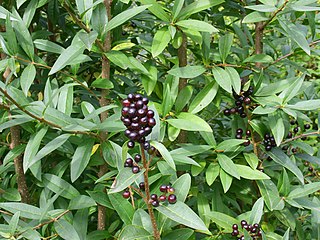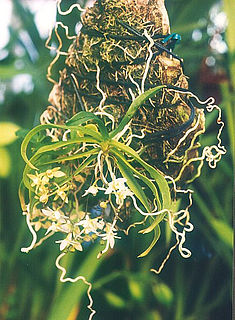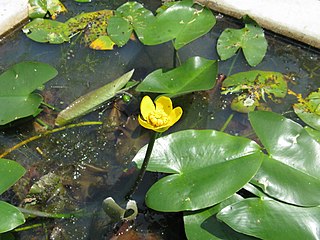
A privet is a flowering plant in the genus Ligustrum. The genus contains about 50 species of erect, deciduous or evergreen shrubs, sometimes forming small or medium-sized trees, native to Europe, north Africa, Asia, many introduced and naturalised in Australasia, where only one species extends as a native into Queensland. Some species have become widely naturalized or invasive where introduced. Privet was originally the name for the European semi-evergreen shrub Ligustrum vulgare, and later also for the more reliably evergreen Ligustrum ovalifolium and its hybrid Ligustrum × ibolium used extensively for privacy hedging, though now the name is applied to all members of the genus. The generic name was applied by Pliny the Elder to L. vulgare. It is often suggested that the name privet is related to private, but the OED states that there is no evidence to support this.

Cornus walteri, also called Walter's dogwood, is a deciduous shrub or small tree 8–16 m tall, native to eastern Asia in Korea and much of China from Liaoning to Yunnan.

Vaccinium erythrocarpum – also commonly known as mountain blueberry, southern mountain cranberry, bearberry, arando, and dingleberry – is a species of cranberry.

Thrixspermum, commonly known as hairseeds or 白点兰属 , is a genus of flowering plants in the family Orchidaceae. Orchids in this genus are epiphytes, lithophytes or terrestrial plants with flat, leathery leaves and short-lived flowers with the sepals and petals more or less similar to each other. The labellum is rigidly fixed to the column and has three lobes. The side lobes are erect and the middle lobe is thick and fleshy. There are about 190 species distributed from tropical and subtropical Asia to the Western Pacific. Most species grow in lowland or tropical rainforests up to an altitude of 1,200 m.

Anthoxanthum, commonly known as hornworts, vernal grasses, or vernalgrasses, is a genus of plants in the grass family.

Ligustrum japonicum, known as wax-leaf privet or Japanese privet is a species of Ligustrum (privet) native to central and southern Japan and Korea. It is widely cultivated in other regions, and is naturalized in California and in the southeastern United States from Texas to Virginia.

Farfugium japonicum is a species of flowering plant in the family Asteraceae, also known as leopard plant, green leopard plant or tractor seat plant. It is native to streams and seashores of Japan, where it is called tsuwabuki (石蕗).

Geum japonicum, known as Asian herb bennet, is a yellow-flowering perennial plant native to North America and East Asia, especially Japan. It may be synonymous with Geum macrophyllum, the North American flower. As a traditional herbal remedy it is known as an astringent and used in poultices. However, in recent years, the Thunberg variant has received attention for other possible medical uses.
Ostrya japonica, known as East Asian hophornbeam, or Japanese hop-hornbeam, is a species of tree in the Betulaceae family growing to 25 m tall. It is native to Japan, Korea and China. In China, it occurs in temperate forests of southern Gansu, Hebei, Henan, Hubei, and Shaanxi provinces at altitudes between 1,000–2,800 metres (3,300–9,200 ft). In Japan it is known as Asada (浅田).

Eupatorium japonicum, known as fragrant eupatorium in English and 白头婆 bai tou po, in Chinese, is a herbaceous plant species in Asteraceae. It is native to China, Japan and Korea.

Cercidiphyllum japonicum, known as the katsura, is a species of flowering tree in the family Cercidiphyllaceae native to China and Japan. It is sometimes called caramel tree for the light caramel smell it emits during leaf fall.

Cypripedium japonicum, known as the Japanese cypripedium and Korean lady's slipper, is a species of orchid. It is native to Japan, Korea and China.

Thrixspermum centipeda, commonly called the centipede thrixspermum, is a species of orchid widespread across southern China, the Himalayas, Indochina, Malaysia, Indonesia and the Philippines.

Aphananthe aspera, commonly known as scabrous aphananthe or muku tree, is a flowering plant in the family Cannabaceae. It is found on slopes and stream banks between 100 and 1600 m. It is native to China, Taiwan, Japan, Korea, and Vietnam.

Erythronium japonicum, known as Asian fawnlily, is a pink-flowered species trout lily, belonging to the Lily family and native to Japan, Korea, the Russian Far East and northeastern China. It is a spring ephemeral, blooming April–June in woodlands. It is known as zhūyáhuā (猪牙花) in Chinese, eolleji (얼레지) in Korean, and katakuri (片栗) in Japanese.
E. japonicum may refer to:

Lygodium japonicum is a species of fern that is known by the common names vine-like fern and Japanese climbing fern. It is native to eastern Asia, including Taiwan, Japan, Korea, southeastern Asia, and India, and eastern Australia. The fern is present in the southeastern United States and Puerto Rico as an introduced species.

Nuphar japonica, known as East Asian yellow water-lily, is an aquatic plant species in the genus Nuphar found in Japan and the Korean Peninsula. It is endangered in Russia. The species was not accepted by The Plant List as of November 2013, which regarded it as an "unresolved name".

Alnus japonica, known as East Asian alder, is a species of Alnus from Japan, Korea, Taiwan, eastern China, and Russia.

Peucedanum japonicum, also known as coastal hog fennel, is a species of Peucedanum, a genus rich in medicinal species belonging to the parsley family, Apiaceae.


















